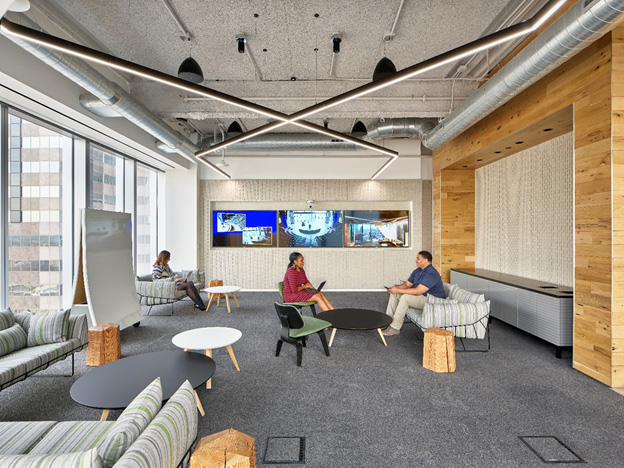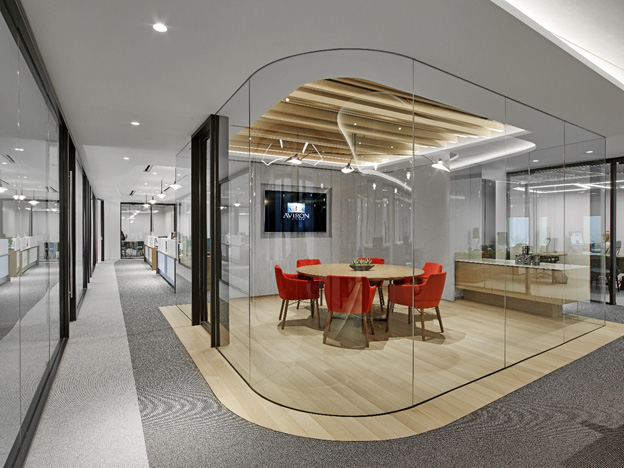Back to the Workplace: Guiding Your Corporate Clients Through Workplace Changes
By Kirsten Nelson

 Many who have experienced the limitations of isolation would attest that productivity is enhanced when we share a workplace or a task with other people. Photo courtesy Diversified.
Many who have experienced the limitations of isolation would attest that productivity is enhanced when we share a workplace or a task with other people. Photo courtesy Diversified.
As new combinations of remote and in-office collaboration continue to develop with the return to the workplace, the role of AV consultants and integrators will have new ramifications in the near- and long-term. The first objective is to help clients navigate immediate questions of health and safety, reconfiguring meeting spaces to maintain social distancing while enabling better connections with remote team members. Then, long-term, a vision must be created for new technology-enhanced modes of working that were accelerated by the COVID-19 pandemic.
Much in the way of future workplace evolution has been proven out during these months of working from home. “We did two years of digital evolution in two months,” observes Kevin Collins, President of Diversified. “As far as how much technology got used, and how much it accelerated, and the scale that was used — it’s like the greatest experiment in history in a sense. And it has good and bad results. But in general, can you imagine a world where we didn't have collaboration platforms and video communications? If we were in this crisis in an analog world, this would be a lot more painful. So, technology is showing that it's able to keep things afloat.”
Related: Back to the Workplace: Human-Centric AV Design Means Asking Workers for Input
Some of the most intriguing new offerings in AI, VR, and immersive experiences were just beginning to make their way into workplace collaboration over the past couple of years, but now they may be indispensable in the new remote collaboration reality. Short-term, Collins points out, these new tools help to make work possible and efficient in a time where health and safety requirements keep us apart. But in the longer term, he suggests, the technology vision needs to encompass a larger analysis of the meaning of work and where technology can enhance it: “We have to think about, how are we productive, how can people fulfill their roles in the most meaningful way for an organization?”
 Office spaces may shrink as more team members work from home. Photo courtesy Diversified.
Office spaces may shrink as more team members work from home. Photo courtesy Diversified.
Many who have experienced the limitations of isolation would attest that productivity is enhanced when we share a workplace or a task with other people. Add to that the additional fulfillment that comes with human connection, and that means we are not about to see the end of the conference room, Collins notes. “The truth is that human creativity and inspiration comes from being together,” he says. “This is not the death knell of us working together.”
Even so, there will likely be a correction in the way that commercial real estate is used, especially in major metropolitan areas. Office spaces may shrink as more team members work from home, and any remaining occupied square footage will need to be remapped to provide safe distancing. “Real estate will level out, and the density per square foot of people is never going to go back to what it was,” Collins notes. Long-term business communications strategies need to reflect that change.
Related: Back to the Workplace: Harnessing Data in AV Designs
Another strategic consideration for the revised workplace is cyber-security. Beyond the ominous threat of hacked video chats, new vulnerabilities may be created by the immersive, “touchless” collaboration environments that many companies will seek as a more hygienic solution. The hands-free benefits of voice control, for example, may come with the risk of illicit eavesdropping. Enterprise customers should make sure they’re working with a cyber-security-savvy AV integrator who can collaborate with IT departments to ensure safety.
Related: AVIXA Webinars | How Do We Ensure That Collaboration is Secure?
Explore the risks, separate out the FUD, and review best practices for achieving and maintaining secure collaboration.
In a time of so much sweeping change, this is the chance to reimagine how technology is incorporated into the workspace, Collins says: “Sometimes you can get over-enamored with what you can do with technology, and you have to take a step back and say, well, what should we do with technology? What is really helpful to people? What is a good user experience? And I think you do that by exposing customers to different technologies, and you see what resonates with people, and then it gets better as it goes. Clearly some new way of working is evolving out of this, and there's a lot of opportunity in that disruption.”
Read Next: Back to the Workplace: Human-Centric AV Design Means Asking Workers for Input



